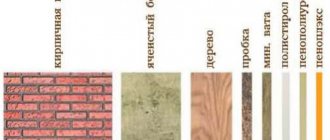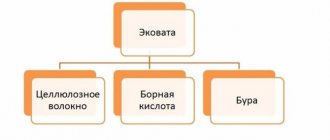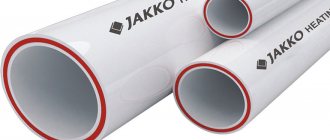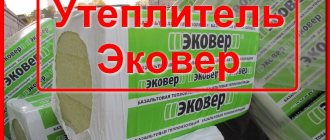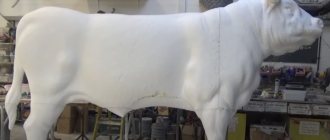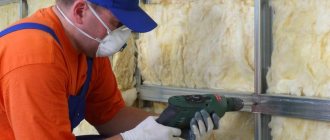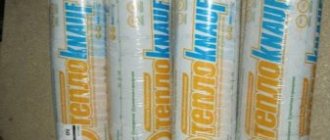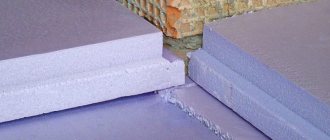Extruded polystyrene foam (EPS) is available in slab form. It is often called penoplex. But you should know that penoplex is a brand (the same as “Giprok” - drywall or “Macroflex” - polyurethane foam). The structure of the insulation under consideration is similar to the structure of conventional polystyrene foam. Being a subtype of polystyrene foam, penoplex is distinguished by its higher density and strength, and has a fine-celled, homogeneous structure consisting of almost completely closed cells. This material is the best type of polystyrene plastic. EPS (penoplex) is made by extrusion, as a result of which polystyrene beads melt, forming a homogeneous mass, which is poured into a mold, where it cools. In this article we will take a detailed look at penoplex insulation, its technical characteristics, advantages, applications and installation features..
Technical characteristics of expanded polystyrene (EPS)
Penoplex is produced by exposing polystyrene granules to high temperature and pressure. By adding a mixture of carbon dioxide and light freon at the next stage, a porous mass is obtained, which is then squeezed out of the extrusion plant. After manufacturing the slabs in the cells, the residual freon is relatively quickly replaced by ambient air.
Penoplex is distinguished among materials for thermal insulation by the following characteristics:
- Low thermal conductivity . The thermal conductivity of penoplex in comparison with other thermal insulation materials is significantly lower and amounts to 0.03 W/m K.
- High compressive and bending strength. Extrusion allows you to achieve uniformity of the material structure. Evenly distributed cells improve the strength characteristics of the material, which does not change its dimensions even under heavy loads.
- Low water absorption (no more than 0.2 - 0.4% by volume in 24 hours). During the tests, XPS boards were left in water for a month. In this case, the liquid was absorbed in small quantities only for the first 10 days, after which the material stopped taking up moisture. At the end of the period, the amount of water in the slabs did not exceed 0.6 percent of their total volume.
- Low vapor permeability (vapor permeability coefficient 0.007-0.008 mg/m·h·Pa). A layer of slabs made of this material, only 2 centimeters thick, has the same vapor permeability as a layer of roofing felt.
- Durability (service life - more than 50 years). Repeated cycles of freezing and thawing the slabs showed that all the characteristics of the material remained unchanged after testing.
- Resistant to combustion . In the manufacture of this material, freons are used, which are safe and non-flammable. They are not poisonous and do not destroy the ozone layer.
- Environmental safety . Most chemicals used in construction are not able to react with penoplex. Exception: toluene, xylene, benzene and similar hydrocarbons; formalin and formaldehyde; ethers, both simple and complex; gasoline, kerosene; oil-based paints and other organic solvents.
- Wide operating temperature range (-50ºС to +75ºС). However, if exposed to excessive heat, the material may melt and ignite.
For clarity, let us highlight all the physical and mechanical properties in the form of a table:
| Indicators | Test method | Dimension | Types of PENOPLEX (old types) | |||||
| Penoplex (31C) | Penoplex wall (31C) | Penoplex foundation (35 without anti-friction) | Penoplex roofing (35) | 45C | 45 | |||
| Density | GOST 17177-94 | kg/m² | 25,0 — 35,0 | 25,0 — 32,0 | 29,0 — 33,0 | 28,0 — 33,0 | 35,0 — 40,0 | 38,1 — 45,0 |
| Compressive strength at 10% linear deformation, not less | GOST 17177-94 | MPa (kgf/cm²;t/m²) | 0,20 (2; 20) | 0,20 (2; 20) | 0,27 (2,7; 27) | 0,25 (2,5; 25) | 0,41 (4,1; 41) | 0,50 (5; 50) |
| Ultimate strength during static bending, not less | GOST 17177-94 | MPa | 0,25 | 0,25 | 0,4 | 0,4 | 0,4 | 0,4 — 0,7 |
| Elastic modulus | UNION DOR SRI | MPa | — | — | — | 15 | 18 | 18 |
| Water absorption in 24 hours, no more | GOST 17177-94 | % by volume | 0,4 | 0,4 | 0,4 | 0,4 | 0,4 | 0,2 |
| Water absorption in 28 days | % by volume | 0,5 | 0,5 | 0,5 | 0,5 | 0,5 | 0,4 | |
| Fire resistance category | Federal Law - 123 | group | G4 | G3 | G4 | G3 | G4 | G4 |
| Thermal conductivity coefficient at (25±)°С | GOST 7076-94 | W/(m °K) | 0,03 | 0,03 | 0,03 | 0,03 | 0,03 | 0,03 |
| Calculated thermal conductivity coefficient under operating conditions “A” | SP 23-101-2004 | W/(m °K) | 0,031 | 0,031 | 0,031 | 0,031 | 0,031 | 0,031 |
| Calculated thermal conductivity coefficient under operating conditions “B” | SP 23-101-2004 | W/(m °K) | 0,032 | 0,032 | 0,032 | 0,032 | 0,032 | 0,032 |
| Sound insulation of the partition (gypsum plasterboard - penoplex 50 mm - plasterboard), Rw | GOST 27296-87 | DB | 41 | 41 | — | 41 | — | — |
| Improvement index for structural noise insulation in floor construction | GOST 16297-80 | DB | 23 | 23 | — | 23 | — | — |
| Standard sizes | Width | mm | 600 | |||||
| Height | mm | 1200 | 2400 | |||||
| Thickness | mm | 20,30,40,50,60,80,100 | 40,50,60,80,100 | |||||
| Operating temperature range | THAT | ºС | -50 to +75 | |||||
Expanded polystyrene is usually sold in packages of 0.25 - 0.3 m³. Depending on the thickness of the sheet, the surface area that can be covered using one package will also vary.
What is it made of? Compound
We have before us a completely artificial material, which is made from chemical components mixed in certain proportions. The technology involves using a temperature of 140 degrees, which causes the ingredients to melt and foam, forming porophores. If we talk about specifics, the following materials are used in production:
- Polystyrene.
- Ground perlite.
- Lemon acid.
- Tetrabromoparaxylene.
- Barium or zinc stearate.
- Bicarbonate of soda.
The use of such components in certain proportions forms a strong cellular-porous structure filled with gas.
Application and types of penoplex
Considering that penoplex has a number of advantages, its scope of application is quite extensive. EPS serves as an excellent insulation material both indoors and outdoors. It is perfect for apartments, houses, cottages and other buildings. Penoplex can be used to insulate roofs, attics, and balconies, in any climatic region without the use of an additional moisture-proof layer. Since the material practically does not absorb water, it is quite possible to use it in an environment with high humidity. At the same time, its thermal conductivity remains almost unchanged. EPS sheets of various thicknesses are available for sale, and depending on the specific requirements, you can always choose the best option.
In addition to a variety of sizes, extruded polystyrene foam is available in several types depending on density and application. Let's look at each type:
- Penoplex Wall. The old name is Penoplex 31 with flame retardants . This material has a density of 25-32 kg/m³ and is intended for effective insulation of external and internal walls, partitions, and plinths. These slabs are also used in the construction of buildings when constructing walls using “well masonry”. Compared to traditional brick walls, such walls are much thinner, but are not inferior to them either in reliability or in the ability to retain heat. In case of insulation of external walls with penoplex, a plaster system can be made on top of the insulation using a mesh, or it can be lined with any façade cladding material (siding, tiles, lining).
- Penoplex Foundation. The old name is Penoplex 35 without fire retardant . This material has a density of 29-33 kg/m³ and has high thermal insulation characteristics, a minimum coefficient of water absorption and resistance to chemical and biological destructive factors. Its water-repellent ability allows it to be used as a waterproofing coating. Penoplex Foundation is a rigid slab with a stepped edge, used in the construction of basements, foundations, and insulation of septic tanks. The slabs are very durable and can withstand significant loads. Therefore, they can also be used as a basis for garden paths, plinths, and floors.
- Penoplex Roofing. The old name is Penoplex 35. This material has a density of 28-33 kg/m³ and well insulates the building from cold air, has minimal water absorption, the ability to insulate noise well, and has a long service life. The slabs have a standard size of 600x1200 mm, but if necessary they can be easily cut with any available tool. And the light weight of the slabs allows them to be used without reinforcing roof structures. The stepped edge located along the perimeter acts as an additional guarantee that “cold bridges” will not form at the joints of the slabs. This type of penoplex can be used to insulate any type of roof. However, more often this insulation is used for insulating flat roofs, as well as for insulating the attic space of a ventilated roof.
- Penoplex Comfort. The old name is Penoplex 31C. This material has a density of 25-35 kg/m³ and has an extremely low thermal conductivity coefficient, high hydrophobicity, and excellent ability to insulate noise. It does not rot and is not a favorable environment for the settlement of insects, mold and fungi. Penoplex Comfort is produced in the form of slabs measuring 600x1200 mm, which have a step-shaped edge along the perimeter. It serves as an additional guarantee of accurate installation. Being a kind of universal, this insulation is simply ideal for thermal insulation of a private house. They can be used to insulate floors, foundations, basements, roofs and walls.
This material has a density of 35-47 kg/m³ and is used as insulation for road surfaces, in particular runways, to prevent them from frost heaving of the soil and destruction of the top layer of the road surface. It is also widely used for insulating roofs in use, on which there are pedestrian areas and various areas, including parking lots.
Penoplex 45.
What is this. History of the creation of the material
The material first appeared back in 1941, when the DOW CHEMICAL company (USA) patented a fundamentally new product with high thermal insulation properties and moisture resistance. The production of the material was put on stream, but initially it was manufactured only for the needs of the Navy.
Due to its resistance to wet environments, Penoplex has been used for the production of life rafts. After some time, the material began to be used in refrigeration units. Penoplex occupied its rightful niche only in 1950, when it began to be used in construction. It is curious that in the US construction market the material is known under the brand name STROYFOAM.
Penoplex is a Russian brand that appeared only in 1988.
What is Penoplex? Essentially, it is foamed polystyrene, which is produced on extrusion machines. In its structure, the material resembles polystyrene foam, which is familiar to many, but has a denser structure and, accordingly, better characteristics.
Installation technology of polystyrene insulation boards
Insulation of external, internal walls and other structures using extruded polystyrene is carried out in several stages. Let's look at each of them:
- The preparatory stage consists of preparing the walls for insulation, cleaning them from dirt, dust, old finishing materials, and paint coatings. In case of large unevenness, it is recommended to level the surface using a plaster mixture (and other methods depending on the design) and treat it with an antifungal compound.
- Fixation using special adhesive facade compounds . The adhesive is applied directly to the insulating board using a comb.
- Mechanical fastening is done using dowels.
- Installation of facade mesh . For better adhesion of the glue to the insulation, you can create roughness on the surface of the slabs. The first plaster layer of façade adhesive is used to fix the reinforcing polymer mesh. Next, a second layer of plaster is applied, after which has dried, the walls are covered with decorative plaster (optional) and painted.
- Instead of plaster, it is possible to decorate the walls with siding, wood, as well as the use of ventilated facades.
EPS installation technology
Thermal insulation of roofs is carried out either at the construction stage or during the reconstruction process, for example, when converting a cold attic into a living space. In this case, the insulation is laid on the base in several layers (the joints of the top layer should not coincide with the joints of the bottom). Next, a vapor-permeable membrane is spread over the penoplex. The resulting cake is secured with longitudinal slats with a thickness of at least 40 mm to ensure ventilation between the insulation and the roofing material.
Available analogues. What is the difference? Which is better and warmer?
- Penoplex or Mineral wool
- Penoplex or Foam plastic
- Technoplex or Penoplex
- Styrex or Penoplex
- Izolon or Penoplex
If you compare these materials, you must take into account their scope of application. For example, mineral wool is definitely not suitable for a foundation or basement: it absorbs moisture well, which leads to weight gain. Accordingly, the insulation slides down, exposing the walls. To avoid these problems, you will have to install additional moisture insulation, and this proportionally increases costs.
However, in terms of heat and sound insulation, Penoplex loses to mineral wool, although the latter material looks more difficult in terms of installation.
Both materials do not absorb moisture, so they are equally suitable for insulating basements. Thermal conductivity indicators are better for Penoplex, but only slightly. It is worth noting that polystyrene foam can be classified as an eternal material, and the service life of Penoplex declared by the manufacturer is 50 years .
Therefore, for internal and external insulation, both materials can be used with equal efficiency, but if service life plays a decisive role, it is better to give preference to polystyrene foam.
These are two materials that are almost identical in their properties. Here you can observe the same indicators of mechanical strength and bending resistance: 250 kPa and 0.4 MPa , respectively.
If we talk about resistance to sub-zero temperatures, then Technoplex looks warmer - the operating temperature of the material: -70 degrees Celsius , however, such temperatures are difficult to meet in most regions of Russia. The thermal conductivity of the insulation is the same: 0.031 W/mK , but Technoplex is more resistant to humid environments.
There are no fundamental differences between these materials, so they have an identical scope of application. Here we can highlight the following difference: Stirex is more resistant to bending deformation, but is more expensive to purchase. In addition, Stirex is more suitable for insulating rooms where there is a significant difference between external and internal temperatures.
Thanks to its structure, Izolon is ideal for insulating floors and roofs, increasing the thermal and sound insulation of rooms. However, for walls it is better to use Penoplex as a material that is more convenient to install.
Useful tips
Insulation using extruded polystyrene foam is effective and simple.
In order for the result to meet expectations, the main advice of professionals is to purchase high-quality thermal insulation materials from trusted suppliers and carry out insulation taking into account the rules and requirements.
By choosing the right adhesive mixture and calculating the required thickness of the insulation, using penoplex you can create a comfortable atmosphere in the house and additional protection outside. Moreover, such insulation will last more than half a century without loss of performance characteristics.
Penoplex production
For the production of expanded polystyrene foamplex, a special extruded installation is used. Granulated polystyrene foam (foam) is loaded into the unit's container, to which catalyst gases are added during the heating process. During the chemical reaction, polystyrene foam begins to foam, turning into a porous mass and increasing in size.
The resulting material is pushed out under pressure. Here the gas evaporates from it, and it gradually hardens. The resulting mass is orange in color and has a bubbly structure. Next, it is fed to machines, where it is cut into smooth, familiar to the consumer’s eye, penoplex slabs.
The high thermal insulation qualities of EPS are ensured by the unique structure of the material. Expanded polystyrene has a fine-cell porous structure (cell diameter from 0.1 to 0.3 mm), each of which is isolated from each other.


